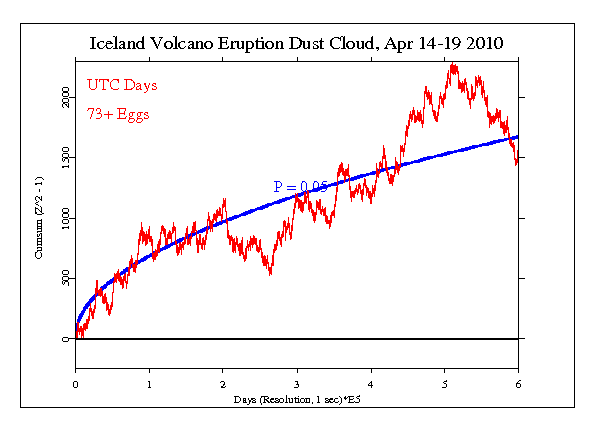|
Iceland Volcano Dust Cloud Stops Air Traffic
While there was no disaster in terms of loss of life, this
event captured worldwide attention, forcefully, for several
days. Under the headline above, a lead article from a South Pacific newspaper
on April 20 says:
"Airlines have lost over $1.7 billion in revenues since a
volcano in southern Iceland erupted, causing cancellations
of flights bound for Europe, the International Air Transport
Association (IATA) said in a statement.
IATA noted that from April 17 to 19, when travel disruptions
were greatest, airlines lost $400 million per day."
From Telegraph.co.uk, a few points in the timeline:
2am Wednesday, April 14 --
After weeks of reduced activity, Eyjafjallajokull volcano in
Iceland erupted beneath its glacier ice cap, which by
midmorning was spewing out a substantial stream of steam and
ash. By midday the surrounding rivers had risen by 10 ft and
a plume of ash had risen through the air to four miles in
the sky.
9am Thursday, April 15 --
NATS announces the whole of British airspace will shutdown
between midday and 6pm, an unprecedented move. After the
September 11 terror attacks in New York, flights continued
on non-transatlantic routes. By the evening Ryanair would
announce it was cancelling all flights for the next four
days – a decision eventually forced upon all other
airlines.
8.40pm Sunday, April 18 --
BA safely lands a test flight in Cardiff, with chief
executive Willie Walsh on board, flying three hours out to
the Atlantic. The next day he declared the "current blanket
restrictions on airspace are unnecessary" after tests came
back saying its engines were unaffected
7am, Tuesday, April 20 --
British airspace due to reopen, starting in Scotland, NATS
has announced. British Airways said it would start flying
out of and into British airports from 7pm on Tuesday.
We could not include this event in the formal series of
hypothesis tests because of its length and because the
beginning of the event literally overlaps with two others,
previously set.
However, there is no question that it meets
many of the criteria we use for selecting formal events. It
was deeply engaging for very large numbers of people; it was
the focus of most news sources for several days; it directly
affected large numbers of travelers.
We set an exploratory analysis for the Volcano Dust Cloud
using the same procedures as for formal events. The event
extends from April 14 to April 19, six full UTC days. The
first day overlaps with two formal events, the Kumbh Mela in
India, and the big earthquake in Qinghai China, the Tibetan
plateau. Since this is an exploration, statistical
interpretation is not warranted, but the graph of
accumulating deviations shows a persistent excess of
correlation in the network, especially on the 14th, and 16th
through 18th.

It is important to keep in mind that we have only a tiny
statistical
effect, so that it is always hard to distinguish signal from
noise. This means that every "success" might be largely
driven by chance, and every "null" might include a real
signal overwhelmed by noise. In the long run, a real effect
can
be identified only by patiently accumulating replications of
similar analyses.
|